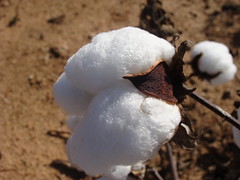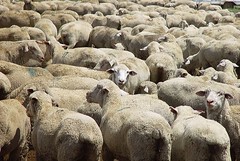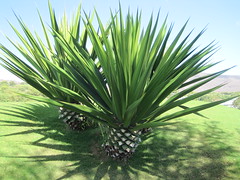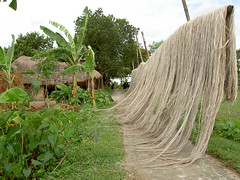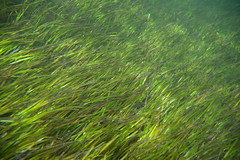In the world of green design regenerative is the new sustainable. While the
concept of sustainability has pushed industry to be less bad, it ultimately
builds upon a linear mindset. On
the other hand, the concept of regeneration evokes circular imagery that is in
tune with how nature ultimately works. That is, in nature virtually everything
is constantly, albeit on different time scales, in a cycle or period of
renewal. In its lifetime an atom of carbon could exist in the
atmosphere as a greenhouse gas, in the soil bound up in a diamond, or perhaps
in a cow as a protein. Regardless of where it came from and where it is going,
the carbon atom will retain its elemental properties and be useful.
This design
for degradation is one of the
12 principles of green chemistry. However, when it comes to manufacturing, the
reality is that some of the products we humans use require complex molecules
that do not form or degrade via natural processes. In these cases, the optimal
scenario is to capture and reuse products’ required inputs and outputs in
continuous cycles. This is
particularly true for items that may go out of style before their functional
life is over.
Carpet happens to be one such product.
That is, Shaw Industries researched carpet turnover and found
that consumers’ choice to update
is based on both aesthetics and performance, typically opting for a new style
and color every eight to ten years. Accordingly, back in the mid-90s when Shaw
Floors decided to expand their existing carpet backing products they focused on
using raw materials that could be endlessly recycled without degradation of
quality or performance.
Following the cradle-to-cradle design
protocol as proposed by McDonough & Braungart Design Chemistry (MBDC), Shaw assessed potential
‘ingredients’ for their recyclability, functionality,
and their human and environmental safety down to a level of 100 parts per
million (ppm). One of the major changes that evolved from such a rigorous
evaluation was the replacement of PVC, and their associated phthalates, with polyolefin
resins.
A few years later in 1999 Shaw was ready
to introduce EcoWorx backing to their tile line. Even though EcoWorx was not officially
MDBC Cradle to Cradle certified until 2007, it did not take long for consumers
to catch on to the product’s worth. In
fact, David Wilkerson, Corporate
Director of Sustainability & Product Stewardship at Shaw, points out that the market responded
very favorably to the new product even without a major consumer education
effort. By the end of 2003
Ecoworx had reached 70% of Shaw’s carpet tile sales and the company decided to
completely phase out their original PVC-based backing, a full two years sooner than was originally
planned!
That’s great news for Shaw because the
environmental benefits of EcoWorx backing increase with sales. That is, while
EcoWorx tiles currently contain roughly 44% recycled content, only 5% of it is
attributed to old EcoWorx tiles
(the other 39% from pre-consumer
waste and post-industrial backing). Therefore,
the more EcoWorx that completes
its lifecycle (i.e. returning to Shaw from corporate facilities, schools,
healthcare facilities, and retailers), the more recycled content, and less
virgin material, EcoWorx products will have.
That doesn’t mean there isn’t already
plenty to celebrate. Before EcoWorx was introduced, the separation of backing from fiber was a
costly aspect of the carpet recycling process. Now that their backing is
polyolefin-based, Shaw can more easily separate it from Nylon 6 through a process known as
elutriation.
In order to catalyze the recovery and
recycling of EcoWorx, all of Shaw’s EcoWorx carpet products come with a Global
Environmental Guarantee. What this means is that when customers decide to
replace their carpet, all they have to do is call the 800 number on the back of
their tile and Shaw will come pick it up. It’s
a win-win, as customers free themselves of waste and potential guilt, Shaw
recovers valuable feedstock. Fortunately
for Shaw’s gas bill (and GHG footprint), since EcoWorx products are 40% lighter than
their PVC-based predecessors, they are less energy intensive to transport.
Upon pickup the carpet’s first
destination is Shaw’s Plant 15 in Cartersville, Georgia, where the tiles are
shredded and polyolefin backing is separated from the Nylon 6 face fibers. The
polyolefin is then made into pellets to eventually become new EcoWorx backing
and the Nylon-6 face fibers move onwards to Shaw’s Evergreen recycling plant in
Augusta, Georgia where approximately 100 million pounds of post-consumer Nylon
6 carpet are recycled per year.
To commend Shaw for their trailblazing
effort with EcoWorx, in 2003 the U.S. Environmental Protection Agency (EPA)
awarded them the Presidential Green Chemistry Challenge Award. However, EcoWorx is only the beginning; 60% of Shaw’s current sales are being
generated by products that are Cradle to Cradle certified.
With that said, when it comes to
regenerative design, as the largest recycler of post consumer carpet in the
world, Shaw is certainly a leader to be admired. However, they are not the only
carpet company rethinking their approach to product design and recovery. Stay
tuned as CARE continues to highlight innovation and excellence across the
industry!


